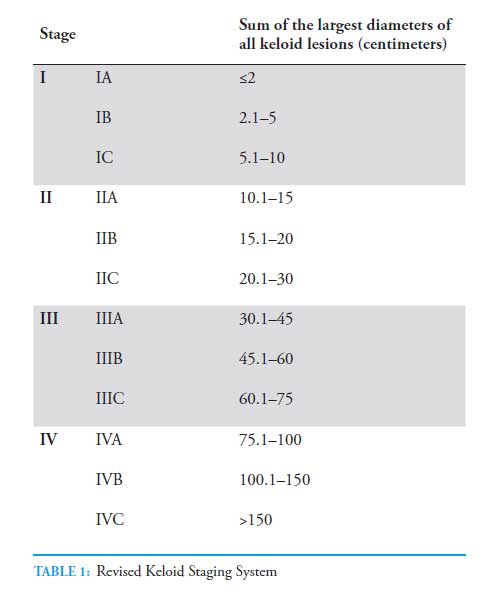“TIRGAN” KELOID STAGING SYSTEM:
In his 2016 publication, Neck Keloids: evaluation of risk factors and recommendation for keloid staging system" Dr. Tirgan introduced a staging system that would allow for proper categorization and grouping of keloid patients into various stages.
In order to validate this stating system, clinical records of a very large cohort of keloid patients that were seen by Dr. Tirgan in his medical practice were analyzed. A repeat analysis of this clinical dataset was conducted independently by a colleague of Dr. Tirgan. As a result of this analysis, the staging was revised. Results of this study was published in 2021 under the title of Cartesian Model of Keloid Growth.
Staging systems have been used in management of cancer patients. It is quite logical to think that a patient with very small, stage one breast cancer will have a different outcome compared to patients with metastatic, stage four breast cancer. Dr. Tirgan, in devising the Keloid Staging System followed the same methodology that has been utilized in staging cancers. TNM cancer staging system has been used for several decades and allows proper stage grouping of cancer patients. A great majority of cancer treatments, clinical trials, and standard treatments are guided by the TNM staging of the cancer. Conduct of oncology clinical trials and interpretation of the trial results are completely dependent on the TNM staging system.
Without such a staging system for Keloid Disorder, the interpretation of published keloid study results has been very difficult. For example, when a study looks at the rate of recurrence of ear keloids after surgery, logic and common sense tells us that patients who only have one keloid on one ear, will have a different rate of recurrence compared to those who have numerous keloids on their skin. Also, those who have had prior surgical removal of their keloids will have a much higher rate of recurrence than those who have never had surgery before.
To assess keloid patients properly, we clearly need a staging system that can allow us to describe the severity of the keloid disorder based on the size, location and/or extent of the keloidal lesions. The keloid staging system devised by Dr. Tirgan will allow for better understand of the natural history of this disorder. It will also enable us to compare future keloid study results among various patients' groups. Other prognostic factors are history of surgery or radiation therapy. Furthermore, there might exist other factors that are currently unknown to us. It is quite conceivable that proper management of keloid patients could be guided by such a staging system. Dr. Tirgan's staging system for keloid disorder is a method that can stratify for such preexisting inherent risks of recurrence, such as response to prior treatments, positive family history, age, gender, race, and so forth.
A well-designed clinical staging system will need to be validated by review of retrospective studies as well as planned prospective clinical trials. Dr. Tirgan is leading these efforts to refine his staging system. In applying this staging system to 1,088 of his own patients, Dr. Tirgan identified areas that needed improvement, as such in 2018, the staging system was slightly revised. Current revision of the Tirgan Staging System is presented here.
